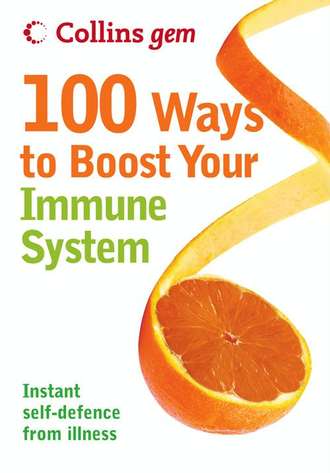
Полная версия
100 Ways to Boost Your Immune System

100 Ways
to Boost Your
Immune System
Theresa Cheung

Table of Contents
Cover Page
Title Page
INTRODUCTION
Part One: Understanding Your Immune System
What is your immune system
Components of your immune system
How your immune system works
Meet the bugs
Signs of infection
The common cold
Flu
Is it a cold or flu?
A word about bird flu
Auto-immune disorders
Allergies
Improving your immunity
Vaccination
The flu jab
Immunity enemies
Is your immune system in trouble?
Making immune-boosting diet and lifestyle choices
Part Two: 100 Immune System Boosters
Boosting immunity with nutrition
Boosting immunity with lifestyle changes
Boosting immunity with supplements
Boost immunity with a fighting spirit
Part Three: Fighting Infection
Working out your immune system
DIY home remedies for colds and flu
Take probiotic supplements
Don’t fly unless necessary
Take good care of yourself
Index
Copyright
About the Publisher
INTRODUCTION
YOUR INVISIBLE ARMY
Without a strong immune system you can’t live younger or longer. Your immune system is your invisible army, working tirelessly around the clock to keep you fit and healthy, and fighting off invasion by foreign organisms that can lead to premature ageing and disease.
A vigorous immune system is vital to good health, both physical and mental. Tiredness, frequent colds and other infections, allergies, mood swings and premature ageing are sure-fire signs of a weakened immune system. Learning how to protect and support your immune system is therefore the most important thing you can do for your health and well-being. Fortunately, there are many ways in which you can strengthen and support your immune system – and keep your troops in peak condition – without resorting to the use of antibiotics.
This book gives you all the advice you need to achieve this healthy state of affairs.
So be good to yourself. Read on to discover everything you need to know to stay free from disease and maximise your potential for high-level health, happiness and vitality.
Drawing on a variety of disciplines in medicine and natural health, each immune booster in this book will provide practical strategies you can use in your daily life to strengthen your resistance to illness. And if you do get sick you’ll find information that will help you get well faster.
What is your immune system
Your immune system is a complex interrelated network of organs, blood cells and chemical reactions that are your body’s basic – and mostly highly effective – defence mechanism against invasion from the hordes of bugs (bacteria, viruses, parasites and fungi) that are constantly trying to get inside you.
Every day a healthy body with a fully functioning immune system sees off potentially dangerous organisms that can trigger illness, as well as protecting against quirks in your cellular system that might potentially develop into cancerous growths. If your immune defences are working at their optimum level of efficiency, your health is likely to be good. If, however, you feel under par or constantly unwell, this suggests that your immune system is compromised.
Compromised immunity can leave you vulnerable to premature ageing and disease, and impair your ability to heal properly and live your life to the full. It’s no surprise that a recent study of healthy centenarians found they had one thing in common: a healthy immune system. A healthy immune system is therefore the key to good health and a long life.
Components of your immune system
The key components of your immune system are the thymus and the lymph system, together with the spleen, bone marrow, white blood cells and antibodies.
The thymus is the source of T cells. T cells – a type of white blood cell or lymphocyte – are the foot-soldiers of your immune system. They destroy invaders that have been detected by B cells, another type of white blood cell. The lymph system transports nutrients to cells and filters waste. Lymph nodes are collections of lymphoid cells found throughout the body, including the neck, armpits and groin. They are connected by a network of lymph-carrying vessels and are the main sites of storage, activation and production of white blood cells.
The spleen filters the blood, looking out for invaders, and also carries out regular ‘MOT checks’ on red blood cells. Bone marrow is the source of new red and white blood cells. White blood cells are actually a collection of cells that work together to destroy bacteria and viruses. There are numerous types of white blood cells: leukocytes, helper T cells, natural killer cells and so on. Finally, there are five primary types of antibody, known as ‘immunoglobins’, each of which responds and binds to a specific invader, preventing it from entering host cells. We need huge quantities of antibodies to protect us from the constant and daily bombardment of bacteria we unknowingly inhale or digest in our food.
How your immune system works
Your immune system is an elaborate, interactive system of cells, chemicals and tissues located throughout your body. When any of its components come into contact with cells or substances – such as bacteria or viruses – to which they are programmed to respond, a series of reactions is triggered that destroys the invaders or renders them harmless.
A cell or chemical that triggers an immune reaction is called an antigen, and that reaction can be either innate or adaptive. The innate immune response produces an immediate, nonspecific immune response to disease-causing antigens that enter or appear inside the body. An army of scavenging white blood cells constantly roams around your body on the lookout for bugs; if a white blood cell detects an ‘enemy’, then it is immediately transported to the nearest lymph node, situated in your neck, armpits and groin, and destroyed without mercy. You can feel this process happening every time your glands become swollen because innate immunity also includes the inflammation or swelling process.
While the innate response is working on the front lines, the adaptive response system is quietly working behind the scenes to find a defence specifically tailored to deal with the antigen. Typically, the adaptive response takes about five to seven days to get completely mobilised; if the antigen works faster than that, you’re in trouble.
Although the immune system is capable of diversifying its defence plan to meet a wide variety of invading antigens – and once immunity to a specific antigen has been developed that immunity will protect against future attacks by antigens that produce similar diseases – it’s important to point out that each antigen requires an individual response. So, if you’ve developed immunity to the chickenpox virus, you still need to develop immunity to deal with the measles virus and if you’ve developed immunity to one strain of flu virus you still need to develop immunity to deal with countless other cold and flu viruses.
Meet the bugs
Your body is under daily attack from infectious agents doing their best to get inside your body. To a bug, your body offers warmth, safety and food; these make it a very attractive proposition.
Bacteria, viruses and other infectious agents live everywhere. You can find them in the air; on food, plants and animals; in soil and in water; and on almost every surface, including those of your own body. They range in size from microscopic single-cell organisms to parasitic worms that can grow to several centimetres in length.
Most of these agents won’t make you ill, but others can cause infection and harm you. Even though your hard-working immune system is powerful and usually successful at defending you from invaders, it does face the constant threat of viruses and bacteria that are forever mutating, and seeking new ways to attack and break down your immune defences. Let’s take a look at the constant threats your immune system faces:
Bacteria and viruses
Among the earliest life forms on Earth, bacteria are self-sufficient, one-celled organisms that are visible under a microscope. Not all bacteria, however, are harmful. Some bacteria that live in your body are actually good for you, such as Lactobacillus acidophilus, the healthy bacteria that reside in your intestines and help you digest food. But when unhealthy bacteria enter your body they can make you ill by rapidly reproducing and secreting toxic chemicals that can damage cells in the tissue they have invaded. Common conditions caused by bacteria include strep throat and gastrointestinal illness triggered by E. coli bacteria, which are often linked to undercooked meat.
Even smaller than bacteria, viruses can only be seen through electron microscopes, high-powered instruments that are used to study very small objects. Unlike bacteria, viruses are not self-sufficient; they need a suitable host in which to reproduce. When a virus such as influenza enters you it takes over healthy cells and spreads through your body, causing illness.
Fungi and parasites
Slightly larger than bacteria, fungi live in the air, water, soil and on plants. Moulds and yeasts are types of fungi that can live in your body but don’t always cause illness. Some fungi such as penicillin – an antibiotic which kills harmful bacteria – have health benefits, but other fungi are not so good for you and can cause illness; an example might be Candida, which can cause yeast infections and oral thrush.
Protozoa are single-celled organisms that spend part of their life cycle outside humans living in food, soil, water or insects, and part of their life cycle living within your body as a parasite. Many protozoa inhabit the intestinal tract and are harmless, but others can cause digestive problems and disease.
Helminths are larger parasites that can enter your body, taking up residence in your intestinal tract where they live off the nutrients in your body. The most common helminths are tapeworms and roundworms.
Signs of infection
Diseases and infections are not the same thing. Infection is the first step to disease when bacteria, viruses or other antigens enter your body and try to multiply and take hold. Disease or illness occur when the cells in your body are damaged by infection, and signs and symptoms of illness will become evident.
Common symptoms of infection, such as sweating, chills, fever, runny nose, sore throat, coughing and sneezing, are all indications that your immune system is doing its job and fighting back. In most cases the natural healing response your immune system offers is effective in warding off invading antigens but sometimes things don’t work so efficiently. Bacteria, a virus or other antigens make it past your immune defences and you get ill. And the most common way to get ill is with a cold or flu virus.
The common cold
It’s called the common cold for a reason; you are more likely to get a cold than any other type of illness. More than 200 different viruses can cause the common cold and there are very few people who escape the infection each year. Most adults get between two and four colds a year and most children get between three and seven as their immune systems are less well developed.
Colds can occur year round but are most common in winter. Symptoms generally include a runny nose, nasal congestion and sneezing, but you may also have a sore throat, cough, headache and mild fever. When someone is down with a cold, his or her nose is teeming with cold viruses and sneezing, nose blowing and nose wiping all spread the virus. You can catch a cold by sitting close to someone with a cold and inhaling the virus or by touching your eyes, nose and mouth after you have touched something contaminated with the virus. People are typically most contagious for the first three days of the cold and not contagious at all after a week.
Once you have caught a cold, symptoms appear within a few days and typically begin with a scratchy throat, followed by sneezing and watery nasal secretions that gradually turn thicker, becoming yellow and green. Most colds are over in a week, with perhaps a few symptoms – such as a cough – lingering on for a further week.
If you get a cold you don’t need antibiotics to treat it unless you have yellow or green nasal discharge for more than 10–14 days. Over-the-counter remedies can offer relief but they won’t cure it. It’s important to rest and drink plenty of fluids.
Flu
Caused by the influenza virus which gives it its name, the ‘flu’ which typically arrives in the winter months is a contagious infection of the nose, throat and lungs. It often begins with a fever, raising your body temperature to 39–41ºC (about 102–106 ºF), and other common symptoms such as body aches, dizziness, lack of energy and a flushed face. The fever can last for up to five days but normally subsides after a day or two. Sometime around day four of the illness the ‘whole body’ symptoms subside and respiratory symptoms, such as coughs, sore throats, runny or blocked noses and sneezing, take centre stage. These symptoms tend to continue for about a week, but coughs and tiredness can linger for weeks after the rest of the illness is over.
The influenza virus is airborne and can be caught by breathing in droplets from coughs or sneezes. Most often, however, it is caught when you touch a tap, phone or door handle with the infection on it, and then touch your mouth, nose and eyes.
Millions of people get influenza every year; most recover but for some the symptoms are so severe that they need to be hospitalised. All ages are at risk of serious complications with flu, but those most at risk include babies, children, pregnant women, people over the age of 60, and anyone with diabetes or a chronic heart, lung or kidney condition.
In most people who are otherwise healthy, influenza subsides within seven to ten days. If you do get flu and are not in a high-risk category, resting, using over-the-counter medications that relieve symptoms, drinking plenty of water and avoiding alcohol, tobacco and antibiotics are the best ways to treat it. (For more advice on DIY methods to ease symptoms of colds and influenza, see ‘Part Three: Fighting Infection’.)
Is it a cold or flu?
Most people get a cold several times a year but fortunately, influenza strikes only once every few years. The flu virus is often mistaken for a cold virus since both these infections share similar symptoms, but the two diseases are very different. For one thing colds tend to go away without causing trouble but influenza can lead to complications such as pneumonia. Being able to spot a case of flu quickly also opens up the possibility of taking antiviral medications, such as Tamiflu and Relenza, which can kill the virus and speed recovery. Once flu is diagnosed, your doctor can determine which one is best for you.
If you aren’t sure if you have a cold or a case of the flu, bear in mind that colds tend to come on gradually. The first sign is often a sore or scratchy throat, followed by a runny nose and sneezing. Other symptoms include coughing, headaches and stuffiness. Also colds don’t usually cause fevers in adults, although they can sometimes do so in children. The flu, on the other hand, leads quickly to a high fever and the symptoms tend to be far more severe. You might feel weak, tired and drained of all energy, and you might also experience chills, a sore throat, strong headaches and aches and pains (including eye pains).
A word about bird flu
Known as ‘avian influenza’, bird flu is a viral disease caused by different strains of the influenza virus. It mostly infects birds. Recent outbreaks in Europe have largely been caused by a highly contagious and virulent strain of the virus known as ‘H5N1’. At present, H5N1 is only mildly infectious to humans who have been in contact with infected birds and it cannot be transmitted from one human to another. However, virus experts fear that the H5N1 virus could mutate and be transferred to humans, or combine with other influenza viruses already infecting humans, causing a 21st-century flu pandemic on the scale of the ‘Spanish flu’ that followed World War I, which killed over 50 million people worldwide.
Research suggests that flu drugs, such as Relenza and Tamiflu, are effective treatments for the disease, although there is concern that such drugs may not be as readily available or as effective as hoped if the virus mutates. In addition, a number of companies are trying to develop a vaccine, although this is proving difficult as the flu virus mutates frequently and the vaccines need to be constantly modified.
Despite growing concern, health experts strongly advise the public not to panic as there is no immediate threat to humans. The World Health Organisation (WHO) has effective disease-control measures in place in areas where outbreaks have occurred or are likely to occur. Currently, the WHO is also creating an emergency plan to handle a pandemic and governments are stockpiling antiviral medications. The best way to protect yourself is to keep your immune system as strong as possible by following the guidelines in this book and by staying away from infected birds.
Auto-immune disorders
A weakened immune system will not only increase your susceptibility to colds and flu, it can also increase your risk of auto-immune disorders in which the immune system attacks healthy body cells.
Normally the immune system is capable of telling the difference between ‘self’ and ‘non-self’ tissue, but auto-immune disorders occur when it can no longer differentiate between the two. Why this happens is still uncertain. Some experts believe that these disorders occur following infection by some kind of organism that looks similar to particular cells in the body, which are later mistaken for the organism and targeted for attack.
In many cases, auto-immune disorders cause the destruction of body tissue, resulting in the decreased functioning of an organ or tissue, or several organs or tissues. Examples of auto-immune disorders include:
Chronic fatigue syndrome: A condition of prolonged weariness and fatigue that is not relieved by rest or caused by other medical conditions. Experts aren’t sure what causes it but one theory is that it is caused by some sort of auto-immune response.
Diabetes (Type 1): A disease that occurs when the pancreas produces too little insulin to regulate blood sugar. Symptoms include increased thirst, weight loss, fatigue and increased urination.
Multiple sclerosis: An auto-immune disease that affects the central nervous system (brain and spinal cord). Symptoms include fatigue, tremors and weakness in one or more extremities.
Pernicious anaemia: Caused by the lack of a substance needed to absorb vitamin B12 from the gastrointestinal track. Symptoms include fatigue, unsteady gait and bleeding gums.
Rheumatoid arthritis: A painful long-term disease that causes inflammation of the joints and surrounding tissues.
Most auto-immune disorders are chronic but can be controlled with medication. The outcome of treatment will vary with the disorder but the aim is to reduce the immune response against normal body tissue while leaving intact the immune response against invading antigens.
Allergies
Allergic disorders occur when the immune system over-reacts to exposure to substances in the environment and triggers defence mechanisms such as swelling, watery eyes and sneezing. The substances that provoke this over-reaction are called allergens, and over-reactions to allergens are typically controlled by medications called antihistamines.
When an allergen enters the body of a person with a sensitive immune system, histamine and other chemicals are released by certain cells. It is these that cause itching, swelling, watery mucus production, skin rashes and other symptoms. Such symptoms are inconvenient and unpleasant but are not life-threatening; treatment generally involves the use of medications, such as antihistamines. Sufferers can also take steps to reduce their exposure to known allergens.
The most common allergic disorders include:
Asthma: A respiratory disorder that involves an allergic response by the lungs and can cause breathing problems. If the lungs are sensitive to certain allergens, such as pollen or dust mites, this can trigger a narrowing of the breathing tubes in the lungs, making it hard for the person to breathe. Asthma symptoms can also be triggered by respiratory infections, exercise, cold air, stress, smoke and other pollutants.
Eczema: An over-sensitive reaction that occurs in the skin and causes a scaly, itchy rash. Exposure to environmental irritants can worsen symptoms, as can dry skin, exposure to water, temperature changes and stress. Consult your doctor for a diagnosis of eczema because it can be hard to differentiate from other skin disorders.
Food allergies (to products such as nuts), seasonal allergies (such as hay fever) and environmental allergies (to organisms such as dust mites). All of these are also caused by an over-sensitive immune system, which leads to an incorrect immune response when the immune system reacts to allergens or substances that are generally harmless.
Improving your immunity
A large number of health problems can be linked to an under-par immune system. On the surface, the symptoms of hay fever may seem quite different from the painful, inflamed joints of arthritis or the wheezing of asthma. They are all triggered, however, by an immune system that is struggling to cope with the pressures being placed on it.
There are a number of reasons why your immune system may be compromised or struggling. It is important to understand that in the majority of cases your immunity can be weakened or strengthened by factors within your control. Although the immune system is less efficient in children and the elderly, even the most susceptible person can boost their immune system by:
keeping up to date with vaccinations
avoiding common enemies of immunity
heeding the warning signs of an immune system under pressure









